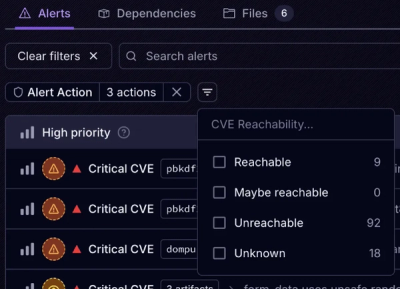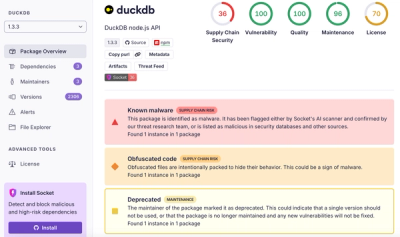
Product
Introducing Tier 1 Reachability: Precision CVE Triage for Enterprise Teams
Socket’s new Tier 1 Reachability filters out up to 80% of irrelevant CVEs, so security teams can focus on the vulnerabilities that matter.
@jeppech/schema-ts
Advanced tools
Small library for creating schemas, that can validate and assert unknown data.
someone: Why not use valibot me: We have valibot at home... valibot at home:
pnpm add @jeppech/schema-ts
import * as v from '@jeppech/schema-ts'
const userdata = {
username: v.string(),
age: v.number(),
email: v.string(v.email()),
created_at: v.timestamp(),
deleted: v.optional(v.timestamp()),
have_you_heard_about_our_extended_warranty: v.bool()
}
type User = v.InferObject<typeof userdata>
/**
* The `User` type will have the following shape, and
* will following any changes made to the object above.
*
* type User = {
* username: string;
* age: number;
* email: string;
* created_at: Date;
* deleted: Option<Date>;
* have_you_heard_about_our_extended_warranty: boolean;
* }
*/
const form = new FormData() // from a request, eg. `await req.formData()`
const result = v.parse(form, userdata)
if (result.is_err()) {
// Contains a list of errors, WIP
console.log(result.unwrap_err())
} else {
// Returns the `User` object
const user = result.unwrap()
}
You can add your own Valuers and Validators, they are just simple functions.
A Valuer is a function, which job is to assert, that the input value is of the type that we want, and return that type.
If this assertion fails, it must throw a ValidationError.
The built-in Valuers takes a variadic number of Validators, which is used to validated the returned value, if needed.
Here's an example of a Valuer, that requires the property to be either admin, user or anonymous. This could also be made as a Validator, but using a Valuer we are returned the concrete type.
const roles = ['admin', 'user', 'anonymous'] as const;
type UserRole = typeof roles[number]
export function role(...validators: v.Validator<UserRole>[]) {
return (value: unknown, field: string) => {
if (typeof value === 'string') {
if (roles.includes(value as UserRole)) {
return v.validate(value as UserRole, field, ...validators);
}
}
throw new v.ValidationError('expected a valid role', value, field);
};
}
const user = {
name: v.string(),
role: v.role()
}
type UserWithRole = v.InferObject<typeof user>
See src/valuers.ts for more examples
A Validator is a function, that is passed as any other argument, besides the first, to the v.as(...) function.
A Validators job is, as the name implies, to validate the input data. If a validation succeeds it must return void/undefined. If it fails, it must return a ValidationError.
As a Validator comes after a Valuer, we can expect an exact type as input data, for the function.
Here's an example of a Validator, that requires a timestamp to be in the future
function in_the_future(err = 'expected a timestamp in the future') {
return (value: Date, field: string) => {
const now = new Date();
if (value < now) {
return new ValidationError(err, value, field);
}
};
}
const notification = {
message: v.string(),
fire_at: v.timestamp(in_the_future())
}
type NotifyInFuture = v.InferObject<typeof notification>
See src/validators.ts for more examples
FAQs
Create schemas for validating unknown data
We found that @jeppech/schema-ts demonstrated a healthy version release cadence and project activity because the last version was released less than a year ago. It has 1 open source maintainer collaborating on the project.
Did you know?

Socket for GitHub automatically highlights issues in each pull request and monitors the health of all your open source dependencies. Discover the contents of your packages and block harmful activity before you install or update your dependencies.

Product
Socket’s new Tier 1 Reachability filters out up to 80% of irrelevant CVEs, so security teams can focus on the vulnerabilities that matter.

Research
/Security News
Ongoing npm supply chain attack spreads to DuckDB: multiple packages compromised with the same wallet-drainer malware.

Security News
The MCP Steering Committee has launched the official MCP Registry in preview, a central hub for discovering and publishing MCP servers.